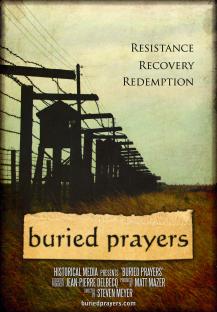Past events
BURIED PRAYERS at New York’s QUAD Cinema
Friday, November 18, 2011
BURIED PRAYERS
Opens November 18, 2011 at New York's QUAD Cinema
A team of 77 – survivors, archaeologists, filmmakers -- excavate the fields of a Nazi death camp bringing what was buried to light.
Narrated by Laurie Anderson
October 19, 2011 New York, NY – NY's QUAD Cinema and Historical Media are proud to present the Jean-Pierre Delbecq—Matt Mazer Production, the documentary feature BURIED PRAYERS (81 minutes), Produced by Matt Mazer and Directed by Steven Meyer.
To the Jewish survivors of the Maidanek death camp in Poland the horrors they experienced as teenagers remain etched in their memories. BURIED PRAYERS brings these memories into a tangible present and documents an extraordinary event.
In October 2005, based upon unique witness testimony, Producer Matt Mazer assembled a film crew and an international team of archaeologists, investigators (from Australia, USA, Germany, Israel, Denmark, Sweden, Italy, England and Poland) and Maidanek survivors from Australia to travel to Lublin, Poland. A prolific documentary and animation producer, it was Mazer's tenth trip to Lublin and he was determined to substantiate the story of Holocaust survivor Adam Frydman, who had a long held secret: that he and his fellow prisoners had buried their possessions in the fields within the Camp. Adam was just 18 years old when his entire family arrived at Maidanek.
Frydman, who emigrated to Australia after the War, revealed the existence of this "burial" ground to Israeli journalist and criminal investigator, Yaron Svoray, who was researching projects for Mazer at Historical Media. Svoray introduced Frydman and several other remarkable survivors to Mazer. "There were many eyewitnesses who corroborated Adam's story ", notes Mazer, "but only those who could make the journey and provide evidence, on the scene—on camera, were subjects of the film. They heroically put aside their trepidations to return, confront the past, and testify."
Mazer worked for 11 months to persuade the Polish authorities to grant him a permit to conduct archaeological "test" research. The permit was issued—but the dig was limited to just 72 hours.
Maidanek, also known as"KZ Lublin", operated in full sight of the town of Lublin (now Poland's "City of Culture") and was one of Nazi Germany's six extermination camps. In 1943, Jews who had survived the Warsaw Ghetto Uprising were relocated to "KZ Lublin". As there was no rail terminal inside the Camp, there was no convenient way of disguising the Jews' arrival, so throughout the months of April and May of 1943, 15,000 Jews were marched through the streets of Lublin to Maidanek.
In Nazi extermination camps the protocol, on the day of arrival, was to select which prisoners were to live and which were to be murdered. But in Maidanek, in the spring of 1943, there was no convenient way of "selecting" so many prisoners. Over the course of three months, thousands of people were held temporarily in the camp's open fields—a no-man's land between the barracks. Realizing that most would be selected for death (day and night they could see and smell stacks of burning bodies) they began, surreptitiously, to bury the few precious personal items they had carried with them.
Without hope, in countless individual acts of courage and defiance, the prisoners buried their watches, necklaces, rings and gold coins a few inches beneath the surface of the field to leave a final record of their existence. "They said, 'let it rot in the ground—the bastards won't get it.'" recalls survivor David Prince, Trustee of the Melbourne, Australia, Holocaust Museum. "It was meant to be found by people exactly like us."
Organized like a military operation, a team of 77 people from 11 countries transformed Maidanek into a crime scene investigation as the evidence in the ground was unearthed, square meter by square meter. Over the course of three days, the excavation brought to light 80 keepsakes hidden for 63 years, substantiating the survivors' stories and making this film one of the rare documents in which the events of the Holocaust are concretized.
"Let me cry," says survivor Tessie Jacob, who is comforted by a fellow survivor when they first arrive at Maidanek. Inside the buildings of the camp, Tessie trembles at the doorway of a small concrete room—the chamber where her parents were gassed. The walls are still stained blue by Zyklon-B; "I came to apologize to them," she wept, "for being alive".
Today in Maidanek, now a State Museum, there is also a brutally oppressive Memorial to the thousands of people who were incinerated there: a low-lying concrete dome, which covers a rounded mountain of human ashes excavated from the Camp. Perhaps no other image in the film so potently epitomizes the film's achievement and the monumental injustice done, than the murmur of survivors saying Kaddish – the Jewish memorial prayer—for their families and friends against the backdrop of these ashes.
"One day I'll be gone and then there'll be no one to tell the story." said Adam Frydman. "The people who died here can't tell the story, except in what they left."
Thus far, less than one per cent of the Maidanek holding fields have been excavated for these artifacts, relics deposited by the living… rather than looted from the dead.
BURIED PRAYERS (81 minutes) Opens November 18, 2011 at New York's QUAD Cinema, 34 West 13th St., New York, NY 10011 p: (212) 255-2243 f 212) 255-2247; quadcinema@aol.com
FOR ADVANCE TICKETS SALES CALL 777-FILM #636 or PURCHASE FROM www.movietickets.com OFFICIAL WEBSITE: www.buriedprayers.com

